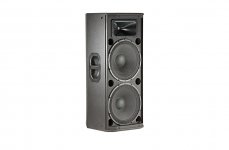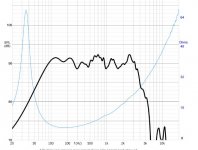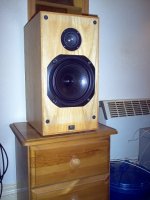Can I use a 16ohm bass mid with 8ohm tweeters and if so would there be any noticeable performance issues. Also what would be resulting impedance for a two way configuration?
Can I use a 16ohm bass mid with 8ohm tweeters and if so would there be any noticeable
performance issues. Also what would be resulting impedance for a two way configuration?
If you need much of a tweeter pad resistor, you may be able to have the entire system 16R impedance.
nigelb63, nobody has made 16 ohm basses in the last 50 years, AFAIK.
They certainly were around about 50 years ago, when valve amplifiers had a 4-8-16 ohm tap on the output transformer.
But really, whatever have you bought that makes for this question? I'm sure it's not anything remotely modern. LOL.
They certainly were around about 50 years ago, when valve amplifiers had a 4-8-16 ohm tap on the output transformer.
But really, whatever have you bought that makes for this question? I'm sure it's not anything remotely modern. LOL.
nigelb63, nobody has made 16 ohm basses in the last 50 years, AFAIK. They certainly were
around about 50 years ago, when valve amplifiers had a 4-8-16 ohm tap on the output
transformer. But really, whatever have you bought that makes for this question? I'm sure it's
not anything remotely modern. LOL.
Not so fast there.
Eminence Speaker MAN O WAR 16 12 Guitar 16 Ohm Guitar Cabinet Woofer | Full Compass
Gallien-Krueger 082 0830 B 10 200W 16OHM Woofer for GLX210 | Full Compass
B&C 8PS21-16 8" Professional Woofer 16 Ohm
B&C 8NDL51-16 8" Professional Neodymium Woofer 16 Ohm
Nobody is stopping you to use a single 16 ohm speaker in a PA cabinet. There are many 16-ohm models from various manufacturers. B&C 16-ohm models are very serious speakers.
"Argument" that 16-ohm models are designed only for twin PA cabinets is the same as the identical "argument" that 8-ohm models are designed only for twin PA cabinets, making 4 ohms. Picture of JBL PRX425, nominal impedance 4 ohms:
"Argument" that 16-ohm models are designed only for twin PA cabinets is the same as the identical "argument" that 8-ohm models are designed only for twin PA cabinets, making 4 ohms. Picture of JBL PRX425, nominal impedance 4 ohms:
Attachments
Last edited:
Yes, you can. Resulting impedance will be 8 ohms, but because low-frequency spectra carries most of the power, it will be an easy load for any amplifier.Can I use a 16ohm bass mid with 8ohm tweeters and if so would there be any noticeable performance issues. Also what would be resulting impedance for a two way configuration?
Sonce, you do talk some tosh. Albeit I am more interested in what nigelb63 says than you, here's the masters of PA speakers, Eminence's view on wiring multiple drive units together:
Wiring Diagrams | Eminence Speaker
Does anybody NOT understand this stuff. 😀
Wiring Diagrams | Eminence Speaker
Does anybody NOT understand this stuff. 😀
The truth is I inadvertently ordered four volt BM220.8 bass mids in 16ohm and I simply don't want to scrap them nor do I want to use two drivers in one cab, if I can help it.
Steve, your advice has helped me out in the past but I've read conflicting advice in other forums. However, from what I've read, the consensus is that an amp would easily drive this configuration.
Steve, your advice has helped me out in the past but I've read conflicting advice in other forums. However, from what I've read, the consensus is that an amp would easily drive this configuration.
You can build excellent monitors with one Volt BM220.8 midbass per box. Which tweeter do you have in mind?
The problem with 16 ohm drivers is that the voice coil wire is thinner than that for an 8 ohm version and is more prone to failure, also the 16 ohm is generally 3db less sensitive than that of an 8 ohm version. The higher impedance of 16 ohms will also require twice the series inductor value of an 8 ohm version but half that in the parallel capacitance value.
Don't be put off, simply wire 2 tweeters in series, one facing forward and the other facing upward for greater ambience. It might work to your advantage.
C.M
Don't be put off, simply wire 2 tweeters in series, one facing forward and the other facing upward for greater ambience. It might work to your advantage.
C.M
However, from what I've read, the consensus is that an amp would easily drive this configuration.
Of course it will. A quality amplifier should have no problems at all with a 16ohm bass & 8ohm tweeter (nominal values). Some SS amps might not thank you for a very high impedance load but 16ohms isn't excessive or uncommon -think of the original 15ohm LS3/5a, and whatever else people think of it, the moderately high 15ohm nominal impedance doesn't usually head the critique list, although other aspects of its behaviour might. What tends to be harder for most amplifiers to drive are very low impedances (< 3ohms, which FWIW is my lower threshold) and highly reactive loads, with a curve that looks like a rollercoaster. The fewer changes the better of course, but broad / progressive alterations typically are no big deal and don't cause difficulties.
Last edited:
Oh my goodness. With apologies to Sonce there, this is quite the interesting topic. 😀
I just reminded myself what the Volt BM220.8 is.
A fabulous and expensive 8" polycone with a substantial solid alloy chassis. TBH, there's not a lot not to like there. 😎
I'd guess a 16 ohm version is not the end of the World. As Tweet says, there is an option to wire two 8 ohm tweeters in series to keep to 16 ohm. My own favourite solution is a cone tweeter with an 8" bass.
But to match impedance, it is not unknown to double the tweeters. TBH, I'd align two tweeters vertically rather than horizontally. But Harold Leak knew what he was doing. Thing is, that a flattish impedance is a good thing, IMO. Gives an amp an easy life. 🙂
I just reminded myself what the Volt BM220.8 is.
A fabulous and expensive 8" polycone with a substantial solid alloy chassis. TBH, there's not a lot not to like there. 😎
I'd guess a 16 ohm version is not the end of the World. As Tweet says, there is an option to wire two 8 ohm tweeters in series to keep to 16 ohm. My own favourite solution is a cone tweeter with an 8" bass.
But to match impedance, it is not unknown to double the tweeters. TBH, I'd align two tweeters vertically rather than horizontally. But Harold Leak knew what he was doing. Thing is, that a flattish impedance is a good thing, IMO. Gives an amp an easy life. 🙂
Attachments
I just reminded myself what the [URL="http://www8/BM220.8[/URL] is.
A fabulous and expensive 8" polycone with a substantial solid alloy chassis. TBH, there's not a lot not to like there. 😎
Hi Steve, I don't think the BM220.8 is at all expensive considering where, how and by whom it's made. Much cheaper than ATC drivers. I only wish I could find a British made tweeter.
Thanks for everyone's input, two tweeters it is then.
A fabulous and expensive 8" polycone with a substantial solid alloy chassis. TBH, there's not a lot not to like there. 😎
Hi Steve, I don't think the BM220.8 is at all expensive considering where, how and by whom it's made. Much cheaper than ATC drivers. I only wish I could find a British made tweeter.
Thanks for everyone's input, two tweeters it is then.
You really don't need two tweeters in series, except if you are planning some sort of bipolar speaker - as Tweet suggested (nothing wrong here!). But I think that chasing 16-ohm total speaker impedance is not worth the additional tweeter, one 8-ohm tweeter and 16-ohm midbass will be an easy load for any amplifier.
- Status
- Not open for further replies.
- Home
- Loudspeakers
- Multi-Way
- Impedance




